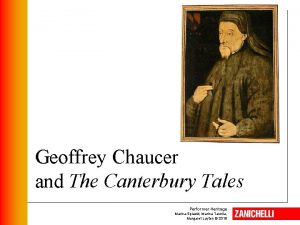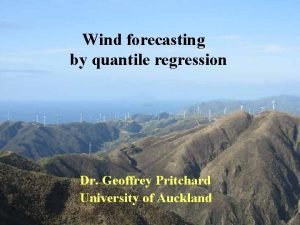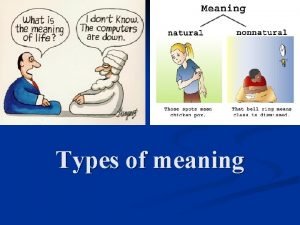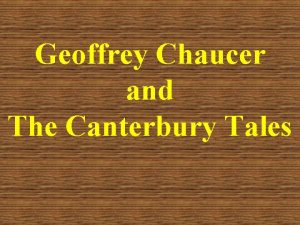Principles of Scientific Simulation Spring Semester 2005 Geoffrey









- Slides: 9

Principles of Scientific Simulation Spring Semester 2005 Geoffrey Fox Community Grids Laboratory Indiana University 505 N Morton Suite 224 Bloomington IN gcf@indiana. edu January Computational Science jsusciencesimulation 05 gcf@indiana. edu 1

Four Descriptions of Matter -Quantum, Particle, Statistical, Continuum • • • Quantum Physics Particle Dynamics Statistical Physics Continuum Physics – These give rise to different algorithms and in some cases, one will mix these different descriptions. We will briefly describe these with a pointer to types of algorithms used. – These descriptions underlie several different fields such as physics, chemistry, biology, environmental modeling, climatology. – indeed any field that studies physical world from a reasonably fundamental point of view. – For instance, they directly underlie weather prediction as this is phrased in terms of properties of atmosphere. – However, if you simulate a chemical plant, you would not phrase this directly in terms of atomic properties but rather in terms of phenomenological macroscopic artifacts - "pipes", "valves", "machines", "people" etc. General Relativity and Quantum Gravity – These describe space-time at the ultimate level but are not needed in practical real world calculations. There are important academic computations studying these descriptions of matter. January 30 2005 jsusciencesimulation 05 gcf@indiana. edu 2

Quantum Physics and Examples of Use of Computation • This is a fundamental description of the microscopic world. You would in principle use it to describe everything but this is both unnecessary and too difficult both computationally and analytically. • Quantum Physics problems are typified by Quantum Chromodynamics (QCD) calculations and these end up looking identical to statistical physics problems numerically. There also some chemistry problems where quantum effects are important. These give rise to several types of algorithms. – Solution to Schrodinger's equation (a partial differential equation). This can only be done exactly for simple 2 -->4 particle systems – Formulation of a large matrix whose rows and columns are the distinct states of the system. This is followed by typical matrix operations (diagonalization, multiplication, inversion) – Statistical methods which can be thought of as Monte Carlo evaluation of integrals gotten in integral equation formulation of problem • These are Grid (QCD) or Matrix January 30 2005 jsusciencesimulation 05 gcf@indiana. edu 3

Particle Dynamics and Examples of Use of Computation • Quantum effects are only important at small distances (10 -13 cms for the so called strong or nuclear forces, 10 -8 cm for electromagnetically interacting particles). • Often these short distance effects are unimportant and it is sufficient to treat physics classically. Then all matter is made up of particles - which are selected from set of atoms (electrons etc. ). • The most well known problems of this type come from biochemistry. Here we study biologically interesting proteins which are made up of some 10, 000 to 100, 000 atoms. We hope to understand the chemical basis of life or more practically find which proteins are potentially interesting drugs. • Particles each obey Newton's Law and study of proteins generalizes the numerical formulation of the study of the solar system where the sun and planets are evolved in time as defined by Gravity's Force Law January 30 2005 jsusciencesimulation 05 gcf@indiana. edu 4

Particle Dynamics and Example of Astrophysics • Astrophysics has several important particle dynamics problems where new particles are not atoms but rather stars, clusters of stars, galaxies or clusters of galaxies. • The numerical algorithm is similar but there is an important new approach because we have a lot of particles (currently over N=107) and all particles interact with each other. • This naively has a computational complexity of O(N 2) at each time step but a clever numerical method reduces it to O(N) or O (Nlog. N). • Physics problems addressed include: – Evolution of early universe structure of today – Why are galaxies spiral? – What happens when galaxies collide? – What makes globular clusters (with O(106) stars) like they are? January 30 2005 jsusciencesimulation 05 gcf@indiana. edu 5

Statistical Physics and Comparison of Monte Carlo and Particle Dynamics • Large systems reach equilibrium and ensemble properties (temperature, pressure, specific heat, . . . ) can be found statistically. This is essentially law of large numbers (central limit theorem). • The resultant approach moves particles "randomly" asccording to some probability and NOT deterministically as in Newton's laws • Many properties of particle systems can be calculated either by Monte Carlo or by Particle Dynamics. Monte Carlo is harder as cannot evolve particles independently. • This can lead to (soluble!) difficulties in parallel algorithms as lack of independence implies that synchronization issues. • Many quantum systems treated just like statistical physics as quantum theory built on probability densities January 30 2005 jsusciencesimulation 05 gcf@indiana. edu 6

Continuum Physics as an approximation to Particle Dynamics • Replace particle description by average. 1023 molecules in a molar volume is too many to handle numerically. So divide full system into a large number of "small" volumes d. V such that: – Macroscopic Properties: Temperature, velocity, pressure are essentially constant in volume • In principle, use statistical physics (or Particle Dynamics averaged as "Transport Equations") to describe volume d. V in terms of macroscopic (ensemble) properties for volume • Volume size = d. V must be small enough so macroscopic properties are indeed constant; d. V must be large enough so can average over molecular motion to define properties – As typical molecule is 10 -8 cm in linear dimension, these constraints are not hard – Breaks down sometimes e. g. leading edges at shuttle reentry etc. Then you augment continuum approach (computational fluid dynamics) with explicit particle method January 30 2005 jsusciencesimulation 05 gcf@indiana. edu 7

Computational Fluid Dynamics • Computational Fluid Dynamics is dominant numerical field for Continuum Physics • There a set of partial differential equations which cover – liquids including blood, oil etc. – gases including airflow over wings and weather • We apply computational "fluid" dynamics most often to the gas air. Gases are really particles • If a small number (<106) of particles, use "molecular dynamics" and if a large number (1023) use computational fluid dynamics. January 30 2005 jsusciencesimulation 05 gcf@indiana. edu 8

What needs to be Solved? • A set of particles or things (cells in biology), transistors in circuit simulation) – Solve couple ordinary differential equations – There are lots of “things” to decompose over for parallelism • One or more fields which are functions of space and time (continuum physics) – Discretize space and time and define fields on Grid points spread over domain – Parallelize over Grid points • Matrices which could need to be diagonalized to find eigenvectors and eigenvalues – Quantun physics – Mode analysis – principal components – Parallelize over matrix elements January 30 2005 jsusciencesimulation 05 gcf@indiana. edu 9

















